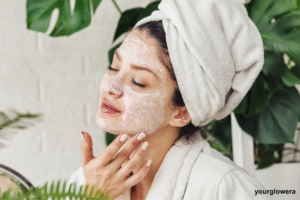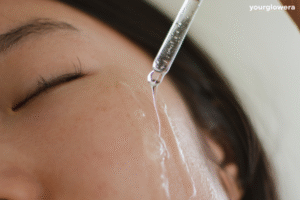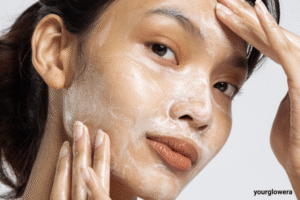Melasma is a common skin condition characterized by the appearance of dark, discolored patches, usually on the face.
If you’re struggling with this condition, establishing the right skincare routine for melasma can help reduce pigmentation and improve your skin’s appearance.
A consistent and well-thought-out skincare routine tailored for melasma is crucial for achieving smoother, more even skin tone.
In this article, we will guide you through the essential steps, the best budget-friendly products, and some expert tips for addressing melasma effectively.
Table of Contents
What is Melasma?
Often referred to as “the mask of pregnancy,” melasma presents as brown or grayish-brown patches that typically develop on areas such as the cheeks, forehead, nose, and chin.
While melasma is harmless, many seek ways to manage it due to its cosmetic impact, and a tailored skincare routine for melasma can play a significant role in reducing its appearance.

Understanding Your Skin: What Works for Melasma?
Before diving into a skincare routine, it’s important to understand that melasma requires a consistent, gentle approach.
Harsh treatments can worsen pigmentation or cause irritation.
A skincare routine for melasma should include products that target pigmentation while protecting the skin from further damage.
Patience is key, as it may take several weeks or months to see noticeable improvements.
Step 1: Gentle Cleanser for Melasma-Prone Skin
A gentle, non-irritating cleanser is essential as the foundation of any effective skincare routine for melasma.
Using a cleanser with a mild formula helps remove dirt and excess oil without stripping the skin’s natural moisture.
Choose a fragrance-free, hydrating cleanser that does not contain harsh chemicals. Look for ingredients like aloe vera, glycerin, or chamomile to soothe and calm the skin.
Budget-Friendly Option: CeraVe Hydrating Cleanser is a great choice for melasma-prone skin, as it is non-foaming, hydrating, and fragrance-free.
Step 2: Exfoliation (But Not Too Much!)
Regular exfoliation can help remove dead skin cells and may assist in reducing hyperpigmentation linked to melasma, making it an essential part of your skincare routine for melasma.
However, it’s important to exfoliate gently and not overdo it, as excessive or harsh scrubbing can irritate the skin and potentially make melasma worse.
Aim for a balanced exfoliation routine that supports skin renewal without causing irritation. Look for mild exfoliants, such as those with alpha hydroxy acids (AHAs) or beta hydroxy acids (BHAs), which are gentle but effective in promoting cell turnover.
Budget-Friendly Option: The Ordinary Glycolic Acid 7% Toning Solution is an affordable, mild exfoliant that gently sloughs off dead skin cells without causing irritation.
Step 3: Use a Vitamin C Serum
Vitamin C is known for its brightening properties, making it an excellent addition to your skincare routine for melasma.
It aids in diminishing the visibility of dark spots and promotes a more even skin tone.
Vitamin C is also a powerful antioxidant that fights against environmental damage, preventing melasma from worsening.
Budget-Friendly Option: La Roche-Posay Pure Vitamin C Face Serum is effective for brightening melasma and is reasonably priced for its quality.
Step 4: Sun Protection: The Most Important Step
Exposure to the sun is a primary factor that can trigger melasma. Without proper sun protection, even the most effective skincare routine for melasma will not yield the desired results.
Daily sunscreen is non-negotiable when treating melasma.
Choose a broad-spectrum sunscreen with an SPF of at least 30 and make sure to apply it every morning, even on cloudy days.
Budget-Friendly Option: Neutrogena Ultra Sheer Dry-Touch Sunscreen SPF 55 provides excellent protection at an affordable price.

Step 5: Retinoids for Melasma
Retinoids, such as retinol, can help improve skin texture and reduce the appearance of dark spots by increasing cell turnover, making them a vital component of an effective skincare routine for melasma.
Retinol is a potent ingredient, so it’s crucial to start with a lower concentration and gradually build up your skin’s tolerance.
Retinoids should be applied at night, as they can make the skin more sensitive to the sun.
Budget-Friendly Option: RoC Retinol Correxion Deep Wrinkle Night Cream is an affordable choice that works to fade dark spots while promoting smoother skin.
Step 6: Brightening Treatments with Niacinamide
Niacinamide is a powerful, multi-benefit ingredient known for its ability to brighten the skin and reduce the appearance of pigmentation.
It can help even out skin tone and improve the skin barrier, making it a great addition to your skincare routine for melasma.
Budget-Friendly Option: The Ordinary Niacinamide 10% + Zinc 1% is a highly effective and affordable product for treating hyperpigmentation.
Step 7: Moisturizing for Hydration and Skin Barrier Support
Melasma-prone skin often becomes dry or irritated, especially when using active ingredients like exfoliants or retinoids, which is why it’s important to balance your skincare routine for melasma with hydrating and soothing products.
Keeping your skin well-moisturized is essential for maintaining a healthy skin barrier and overall skin health.
Look for a moisturizer with hydrating ingredients like hyaluronic acid, glycerin, and ceramides to ensure long-lasting hydration.
Budget-Friendly Option: Vanicream Moisturizing Cream is a fragrance-free, non-comedogenic option that provides excellent hydration for sensitive skin.
Step 8: Masking for Extra Care
Applying a face mask once or twice a week can provide your skin with an extra boost, helping to improve its appearance, hydration, and overall health, making it a valuable addition to your skincare routine for melasma.
Look for masks with ingredients like turmeric, honey, or clay, which can brighten and purify the skin without causing irritation.
Budget-Friendly Option: Aztec Secret Indian Healing Clay is an affordable, deep-cleansing mask that can help with melasma when used once a week.
Step 9: Be Consistent and Patient
Absolutely, consistency is crucial when managing melasma. Stick to your skincare routine for melasma, and avoid jumping between products to ensure the best results.
Additionally, being patient is important, as melasma often takes time to fade, and ongoing care is key to seeing improvement.
With the right approach, your skin will gradually show signs of improvement.
Step 10: Seek Professional Help if Needed
While over-the-counter products can help, melasma may not always respond to topical treatments alone.
In some cases, seeing a dermatologist or licensed skincare professional for treatments like chemical peels or laser therapy may be necessary for more persistent melasma.
Conclusion: Transform Your Skin with the Right Routine
With the right skincare routine for melasma, you can gradually reduce the appearance of pigmentation and achieve a brighter, more even complexion.
Be sure to follow the steps above and stay committed to your routine.
With consistent care, patience, and the use of effective, budget-friendly products, your skin will transform and you’ll feel more confident every day.

In addition to the tips provided in this post, skincare routine for melasma can significantly reduce the appearance of dark spots and even out your skin tone.
By consistently following the right steps, you can transform your skin and feel more confident in your appearance.
For those looking for even more tips on skincare routine for melasma, be sure to check out our detailed guide on how to treat and prevent dark spots effectively. Our expert-recommended skincare routine for melasma will help you achieve the results you’ve been searching for!
Also, read this post on “Say Goodbye to Dark Spots with This Effective Skincare Routine for Melasma“ for more advanced skincare tips to enhance your results!
Frequently Asked Questions
Which fruit is best for melasma?
Fruits rich in Vitamin C, like oranges, kiwis, and strawberries, can support skin health and help lighten pigmentation.
Can coconut oil remove melasma?
While coconut oil has moisturizing properties, it’s not proven to treat melasma. Stick to products with more targeted ingredients like hydroquinone or vitamin C.
Can lemon remove melasma?
Lemon juice contains citric acid, which can lighten skin, but it is harsh and may irritate sensitive skin, especially if you have melasma. Use with caution.
Can I use niacinamide every day?
Yes, niacinamide is generally safe for daily use. It can help with skin tone and texture without causing irritation.
What is the difference between melasma and pigmentation?
Melasma is a form of hyperpigmentation, often triggered by hormonal changes or sun exposure. Pigmentation, in general, refers to any discoloration or dark spots on the skin.
Can kojic acid treat melasma?
Yes, kojic acid can help lighten skin and treat melasma by inhibiting melanin production, which helps reduce dark spots.
How can I permanently remove melasma?
Melasma can be managed with treatments like topical medications, chemical peels, lasers, and consistent sun protection, but it may not be permanently removable. Maintenance is key.
How do dermatologists remove melasma?
Dermatologists use treatments like topical prescription creams (hydroquinone, retinoids), chemical peels, laser therapy, and micro needling to treat melasma.
What is the Chinese treatment for melasma?
Traditional Chinese Medicine may use herbal remedies, acupuncture, and topical treatments aimed at balancing internal body factors and improving skin health.
What darkens melasma?
Sun exposure, heat, certain medications, and inflammation can darken melasma spots. Always use sunscreen to prevent worsening.









Leave a reply